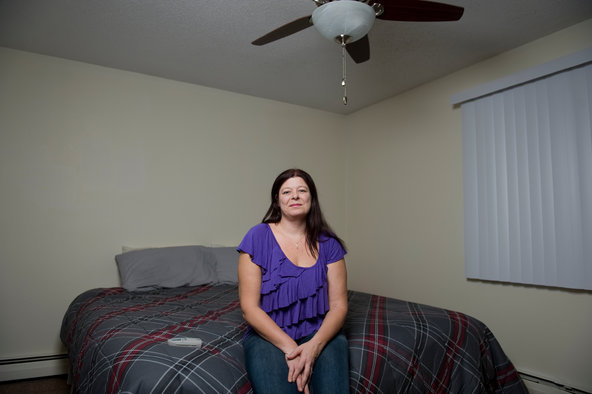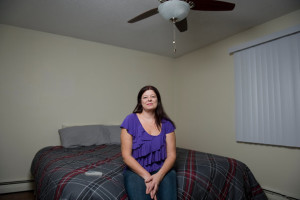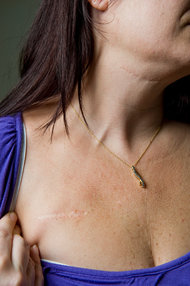For Sleep Apnea Patients, a Possible Alternative to Masks

Notes from Dr. Norman Blumenstock:
Long-term impact of stimulation of the nerve in the jaw, called the hypoglossal nerve, is not known.
By CATHERINE SAINT LOUIS
 Stephen Maturen for The New York TimesJackie Kopplin of Coon Rapids, Minn., had an upper airway stimulator implanted to help treat obstructive sleep apnea.
Stephen Maturen for The New York TimesJackie Kopplin of Coon Rapids, Minn., had an upper airway stimulator implanted to help treat obstructive sleep apnea.
The standard treatment for people with moderate to severe obstructive sleep apnea is a mask worn at night that helps them breathe without interruption. The mask is unwieldy and uncomfortable, however; one study found that46 percent to 83 percent of patients with obstructive sleep apneado not wear it diligently.
Now scientists may have found an alternative, at least for some patients: a pacemaker-like device implanted in the chest that stimulates a nerve in the jaw, helping to keep part of the upper airway open. The device, called a neurostimulator, helped reduce breathing interruptions and raise blood oxygen levels in about two-thirds of sleep apnea patients participating in a trial, researchers reported on Wednesday in The New England Journal of Medicine.
“This is a new paradigm of surgical treatment that seems to effectively control obstructive sleep apnea in selected patients,” said Dr. Sean M. Caples, a sleep specialist in the division of pulmonary and critical care medicine at Mayo Clinic in Rochester, Minn. “It’s very exciting.”
Still, Dr. Caples, who was not involved in the new study, noted that “a third of patients were not improved when all was said and done,” even though they were chosen because they were seen as likely to benefit.
The new trial was funded by the maker of the device, Inspire Medical Systems.
At 22 sites internationally, in 126 patients, doctors surgically implanted a remote-controlled neurostimulator that, activated at night, sends regular electric impulses to a nerve inside the jaw. The impulses cause the tongue to move forward during inhalation, opening the airway.
Patients experienced a decline in breathing pauses after using the device for a year, to 9 per hour on average, from 29.3 episodes per hour. The number of dangerous drops in blood oxygen levels also declined, to 7.4 per hour on average, from 25.4 per hour.
There was no control group during this phase of the study, however, and other experts said that diet, exercise or other factors may have contributed to the reductions.
At a year, only two of 126 patients stopped using their upper airway stimulator at night, and 86 percent reported daily use. But sleep apnea worsened in about 20 patients using the device, though it is unclear why.
In the second phase of the study, 46 patients doing well with the stimulators after one year were randomly assigned to either continue with the therapy or have it withdrawn for a week. The therapy-continuation group had little change in the number of breathing pauses per hour or drops in blood oxygen levels. But in the patients from whom the stimulation therapy was withdrawn, the number of such breathing pauses increased sharply, to 25.8 per hour on average from 7.6 per hour. The episodes of blood oxygen level drops rose to 23 per hour on average, from 6 per hour.
“That rebound was compelling evidence that this device did something for their sleep apnea,” said Dr. Christine H. Won, the medical director of the Yale Sleep Center.
An alternative therapy for patients who cannot or will not use the standard continuous positive airway pressure, or CPAP, masks diligently would be “very valuable,” Dr. Won said.
The neurostimulator is not yet approved by the Food and Drug Administration and may only benefit a subset of sleep apnea patients, including those with a body mass index of less than 32 and people whose obstructions stem from airway collapse behind their tongues. Only patients who could not or would not use mask therapy participated.
Experts disagreed on how widely beneficial this kind of stimulation might be.
“Many people have a problem with upper airway dilator muscles, so my hunch is this would work in a decent number of them,” said Dr. Atul Malhotra, chief of pulmonary and critical care medicine at the University of California, San Diego, who wrote an editorial accompanying the new study.
Dr. Lawrence J. Epstein, a co-director of the sleep medicine clinic at Brigham and Women’s Hospital in Boston, said the study showed “the success of a relatively novel alternative for a disease that has major health implications.”
But he warned the technology would not be a universal option, especially for obese patients.
When patients stop using the masks, they sometimes get surgery to advance their jaw or to trim part of the soft palate. But “those surgeries, which are associated with substantially more pain at least initially, have not been as effective as we would like,” said Dr. Patrick J. Strollo, the lead author of the new study.
The new device “doesn’t require surgery that reconfigures the airway,” said Dr. Strollo, the medical director of the sleep center at the University of Pittsburgh Medical Center.
Less than 2 percent of study participants experienced serious adverse events. Still, more than half reported discomfort from stimulation, tongue abrasion, incision discomfort and other issues.
After her chin incision became inflamed after implantation of the neurostimulator in 2011, Jackie Kopplin, 45, who runs a housecleaning business in Coon Rapids, Minn., was “blown up like a basketball” and in pain for six weeks. “I was regretting it at first,” she said.
But she now sleeps eight to nine hours at night, is not bothered by the tongue thrusting, and no longer dozes off while driving.
As long as she remembers to turn on the stimulator nightly, Ms. Kopplin said, “I wake up and I have energy to make it through the whole day.”
Long-term impact of stimulation of the nerve in the jaw, called the hypoglossal nerve, is not known, Dr. Malhotra said. “This is a lifelong disease. A year in the grand scheme of things is not very long.”
Originally posted: http://well.blogs.nytimes.com/2014/01/08/for-sleep-apnea-patients-a-possible-alternative-to-masks/?action=click&contentCollection=Booming&module=MostEmailed&version=Full%C2%AEion=Marginalia&src=me&pgtype=article&_r=1
Long-term impact of stimulation of the nerve in the jaw, called the hypoglossal nerve, is not known.
 Stephen Maturen for The New York TimesJackie Kopplin of Coon Rapids, Minn., had an upper airway stimulator implanted to help treat obstructive sleep apnea.
Stephen Maturen for The New York TimesJackie Kopplin of Coon Rapids, Minn., had an upper airway stimulator implanted to help treat obstructive sleep apnea.The standard treatment for people with moderate to severe obstructive sleep apnea is a mask worn at night that helps them breathe without interruption. The mask is unwieldy and uncomfortable, however; one study found that46 percent to 83 percent of patients with obstructive sleep apneado not wear it diligently.
Now scientists may have found an alternative, at least for some patients: a pacemaker-like device implanted in the chest that stimulates a nerve in the jaw, helping to keep part of the upper airway open. The device, called a neurostimulator, helped reduce breathing interruptions and raise blood oxygen levels in about two-thirds of sleep apnea patients participating in a trial, researchers reported on Wednesday in The New England Journal of Medicine.
“This is a new paradigm of surgical treatment that seems to effectively control obstructive sleep apnea in selected patients,” said Dr. Sean M. Caples, a sleep specialist in the division of pulmonary and critical care medicine at Mayo Clinic in Rochester, Minn. “It’s very exciting.”
Still, Dr. Caples, who was not involved in the new study, noted that “a third of patients were not improved when all was said and done,” even though they were chosen because they were seen as likely to benefit.
The new trial was funded by the maker of the device, Inspire Medical Systems.
At 22 sites internationally, in 126 patients, doctors surgically implanted a remote-controlled neurostimulator that, activated at night, sends regular electric impulses to a nerve inside the jaw. The impulses cause the tongue to move forward during inhalation, opening the airway.
Patients experienced a decline in breathing pauses after using the device for a year, to 9 per hour on average, from 29.3 episodes per hour. The number of dangerous drops in blood oxygen levels also declined, to 7.4 per hour on average, from 25.4 per hour.
There was no control group during this phase of the study, however, and other experts said that diet, exercise or other factors may have contributed to the reductions.
At a year, only two of 126 patients stopped using their upper airway stimulator at night, and 86 percent reported daily use. But sleep apnea worsened in about 20 patients using the device, though it is unclear why.
In the second phase of the study, 46 patients doing well with the stimulators after one year were randomly assigned to either continue with the therapy or have it withdrawn for a week. The therapy-continuation group had little change in the number of breathing pauses per hour or drops in blood oxygen levels. But in the patients from whom the stimulation therapy was withdrawn, the number of such breathing pauses increased sharply, to 25.8 per hour on average from 7.6 per hour. The episodes of blood oxygen level drops rose to 23 per hour on average, from 6 per hour.
“That rebound was compelling evidence that this device did something for their sleep apnea,” said Dr. Christine H. Won, the medical director of the Yale Sleep Center.
An alternative therapy for patients who cannot or will not use the standard continuous positive airway pressure, or CPAP, masks diligently would be “very valuable,” Dr. Won said.
The neurostimulator is not yet approved by the Food and Drug Administration and may only benefit a subset of sleep apnea patients, including those with a body mass index of less than 32 and people whose obstructions stem from airway collapse behind their tongues. Only patients who could not or would not use mask therapy participated.
Experts disagreed on how widely beneficial this kind of stimulation might be.
“Many people have a problem with upper airway dilator muscles, so my hunch is this would work in a decent number of them,” said Dr. Atul Malhotra, chief of pulmonary and critical care medicine at the University of California, San Diego, who wrote an editorial accompanying the new study.
Dr. Lawrence J. Epstein, a co-director of the sleep medicine clinic at Brigham and Women’s Hospital in Boston, said the study showed “the success of a relatively novel alternative for a disease that has major health implications.”
But he warned the technology would not be a universal option, especially for obese patients.
When patients stop using the masks, they sometimes get surgery to advance their jaw or to trim part of the soft palate. But “those surgeries, which are associated with substantially more pain at least initially, have not been as effective as we would like,” said Dr. Patrick J. Strollo, the lead author of the new study.
The new device “doesn’t require surgery that reconfigures the airway,” said Dr. Strollo, the medical director of the sleep center at the University of Pittsburgh Medical Center.
Less than 2 percent of study participants experienced serious adverse events. Still, more than half reported discomfort from stimulation, tongue abrasion, incision discomfort and other issues.
After her chin incision became inflamed after implantation of the neurostimulator in 2011, Jackie Kopplin, 45, who runs a housecleaning business in Coon Rapids, Minn., was “blown up like a basketball” and in pain for six weeks. “I was regretting it at first,” she said.
But she now sleeps eight to nine hours at night, is not bothered by the tongue thrusting, and no longer dozes off while driving.
As long as she remembers to turn on the stimulator nightly, Ms. Kopplin said, “I wake up and I have energy to make it through the whole day.”
Long-term impact of stimulation of the nerve in the jaw, called the hypoglossal nerve, is not known, Dr. Malhotra said. “This is a lifelong disease. A year in the grand scheme of things is not very long.”
Originally posted: http://well.blogs.nytimes.com/2014/01/08/for-sleep-apnea-patients-a-possible-alternative-to-masks/?action=click&contentCollection=Booming&module=MostEmailed&version=Full%C2%AEion=Marginalia&src=me&pgtype=article&_r=1





